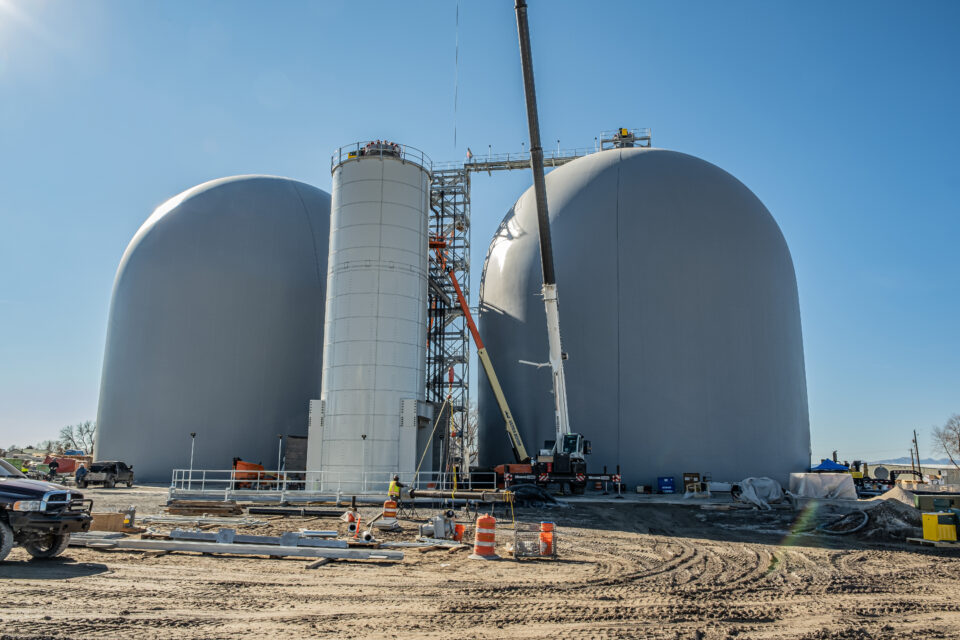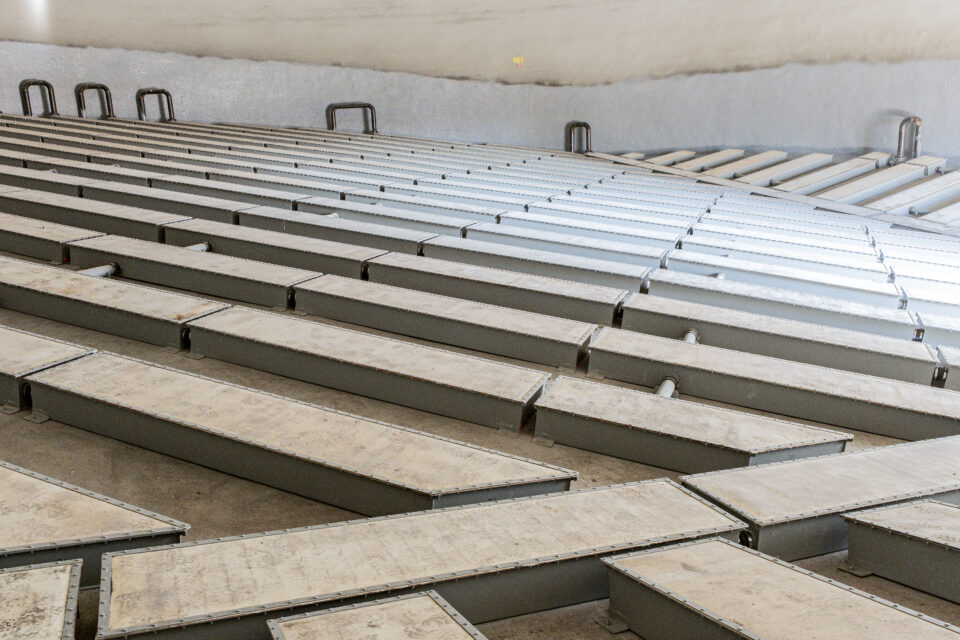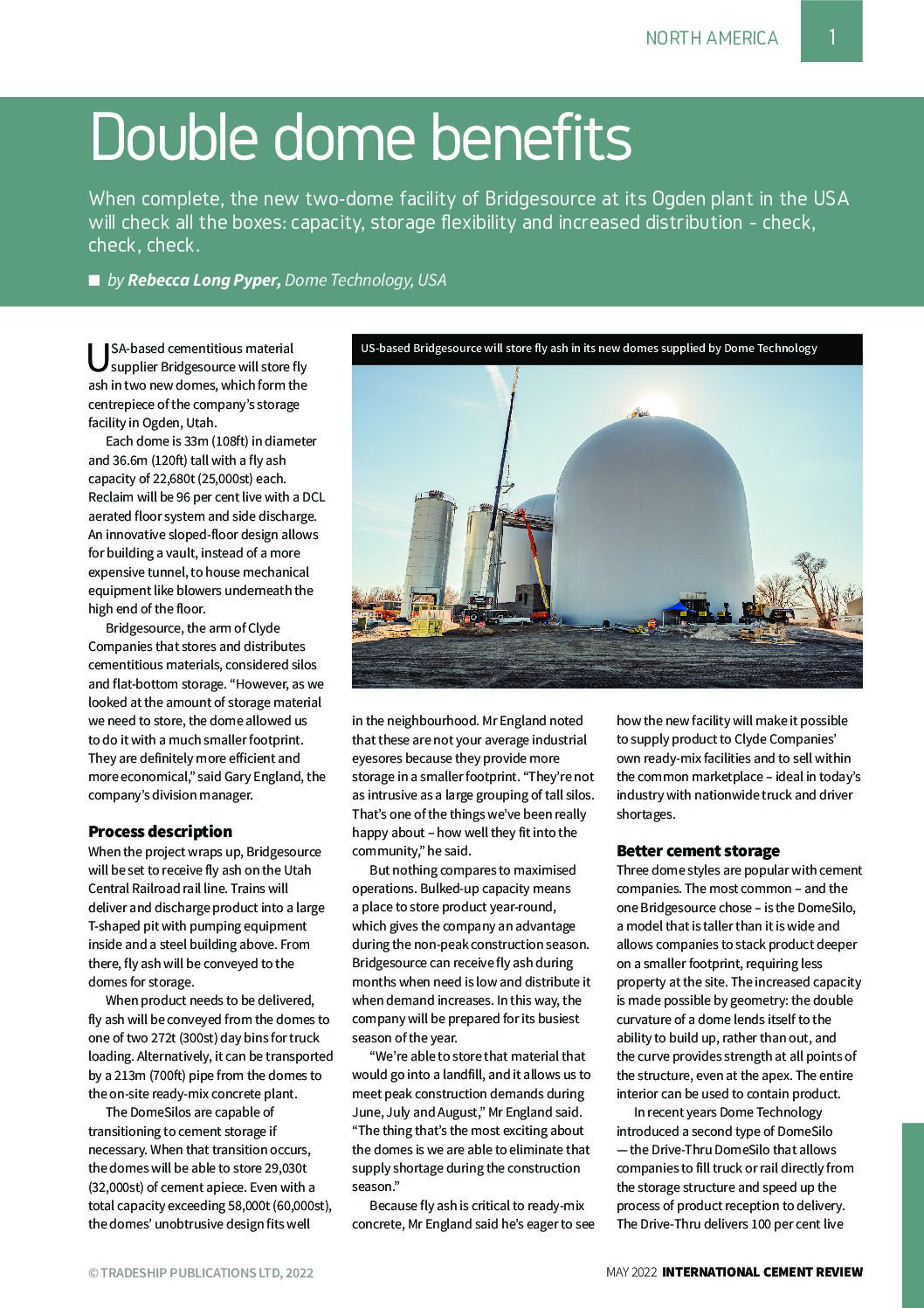Talk about a massive upgrade: When complete, cementitious-material supplier Bridgesource’s new two-dome facility in Ogden, Utah, USA, will check all the boxes. Capacity, storage flexibility, increased distribution? Check, check, check.
Fly ash will be stored in the two new domes, the centerpiece of the storage facility. Each dome is 108 feet in diameter and 120 feet tall with a fly-ash capacity of 25,000 short tons each. Reclaim will be 96 percent live with a DCL aerated floor system and side discharge. An innovative sloped-floor design allows for building a vault, instead of a more expensive tunnel, to house mechanical equipment like blowers underneath the high end of the floor.
Bridgesource, the arm of Clyde Companies that stores and distributes cementitious materials, considered silos and flat-bottom storage, but “as we looked at the amount of storage material we need to store, the dome allowed us to do it with a much smaller footprint. They’re definitely more efficient and more economical,” said division manager Gary England.
When the project wraps up, Bridgesource will be set to receive fly ash on the Utah Central Railroad rail line. Trains will deliver and discharge product into a large T-shaped pit with pumping equipment inside and a steel building above. From there, fly ash will be conveyed to domes for storage.
When product needs to be delivered, fly ash will be conveyed from the domes to one of two 300 short-ton day bins for truck loading. Alternately, it can be transported by a 700-foot pipe from the domes to the on-site ready-mix concrete plant.

The DomeSilos are capable of transitioning to cement storage if necessary; when that transition occurs, the domes will be able to store 32,000 short tons of cement apiece. Even with a total capacity exceeding 60,000 tons, the domes’ unobtrusive design fits well in the neighborhood. England noted that these aren’t your average industrial eyesores because they provide more storage in a smaller footprint. “They’re not as intrusive as a large grouping of tall silos. That’s one of the things we’ve been really happy about—how well they fit into the community,” he said.
But nothing compares to maximized operations. Bulked-up capacity means a place to store product year-round, which gives the company an advantage during the non-peak construction season. Bridgesource can receive fly ash during months when need is low and distribute it when demand increases. In this way, the company will be prepared for its busiest season of the year.
“We’re able to store that material that would go into a landfill, and it allows us to meet peak construction demands during June, July and August,” England said. “The thing that’s the most exciting about the domes is we are able to eliminate that supply shortage during the construction season.”
Because fly ash is critical to ready-mix concrete, England said he’s eager to see how the new facility will make it possible to supply product to Clyde Companies’ own ready-mix facilities and to sell within the common marketplace—ideal in today’s industry with nationwide truck and driver shortages.
Better cement storage
Three dome styles are popular with cement companies. The most common—and the one Bridgesource chose—is the DomeSilo, a model that’s taller than it is wide and allows companies to stack product deeper on a smaller footprint, requiring less property at the site. The increased capacity is made possible by geometry: The double curvature of a dome lends itself to the ability to build up, rather than out, and the curve provides strength at all points of the structure, even at the apex. The entire interior can be used to contain product.
In recent years Dome Technology introduced a second type of DomeSilo: the Drive-Through DomeSilo that allows companies to fill truck or rail directly from the storage structure and speed up the process of product reception to delivery. The Drive-Thru delivers 100 percent live reclaim from a fully aerated floor. Product flows through a hopper for loading into truck and/or rail. An in-line lump crusher on the loadout stack-up ensures that lumps passed through the receiving system do not make it into trucks.
The third dome model Dome Technology continues to build is the hemispherical dome, particularly at sites with a height restriction. These domes are essentially a sphere sliced in half. These structures are the original dome storage model and an economical solution.
Reducing the size and cost of the reclaim system also plays a major part in overall project cost. This often helps determine the most economical dome geometry and most efficient storage option.
Dome storage benefits
Storage is often one of the largest components in any new facility, and a dome is built with an unlimited lifespan—its concrete shell and geometry boast unrivaled strength. Dome construction methods require no interior trusses, so the entire inside volume can be utilized for storage or reclaim systems.
All domes provide ideal conditions for stored materials requiring a controlled environment. Seamless concrete construction, coupled with a fabric membrane surrounding the entire dome, prevents water and moisture from seeping in. The dome’s insulated nature reduces heating and cooling of the walls and air inside, preventing condensation from forming on the interior. Foam and concrete provide humidity control and moderate externally generated temperature fluctuations.
A dome’s strength and geometry also provide a tolerance for differential settlement. Those qualities combined with geotechnical engineering and site analysis ensure proper foundation selection and performance.

Engineering
Even with all the bells and whistles, England said the new Bridgesource facility feels simple and straightforward.
Dome Technology kept things simple by maximizing conversations and sharing tasks with Bridgesource. For deep foundations, Dome Technology provided options and found economical solutions that shaved costs. The two companies discussed the rail-receiving area and opted to divide and conquer; because of Bridgesource’s concrete capabilities, Dome Technology designed the pit, and Bridgesource built it. A double-decker building was constructed on site with electrical components in the lower half and offices in the upper, so personnel have a prime vantage point when trucks pull in.
In every project Dome Technology’s engineering team collaborates early and often with customers to ensure demands are met and automation is optimized.
“That’s an expression of our expertise,” Dome Technology CEO Bradley Bateman said. “Because we knew what Bridgesource needed, we applied our industry knowledge and the current technology and made a simple solution to a complex problem.”
Conclusion
Dome Technology began Bridgesource’s deep-foundation systems in Spring 2021, and project completion is scheduled for Summer 2022. From day one, the company will be ready to receive fly ash from train, pneumatically convey it into either dome, load into trucks or convey to the on-site batch plant. That’s a lot of flexibility for distribution, and it’s one of the reasons England said domes are a good match for cement companies.
“I’d absolutely recommend domes to others. If you’ve got to store 20,000 tons or more, they’re more economical, they’re more efficient and they’re more reliable,” he said.
By Rebecca Long Pyper for Dome Technology
Editor’s note: This article was published in the May 2022 issue of International Cement Review.
